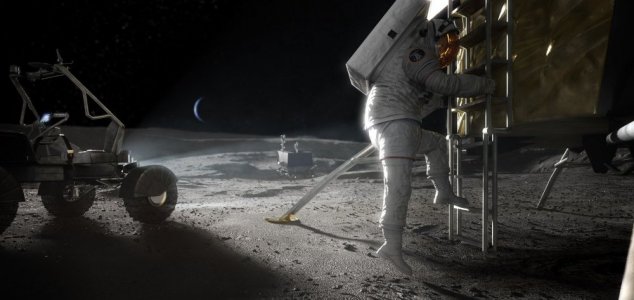NASA outlines goals for crewed Moon mission
Posted on Tuesday, 8 December, 2020

Mankind is going back to the Moon. Image Credit: NASA
In addition to landing humans on the Moon, the Artemis III mission will aim to achieve several scientific goals.
Launching aboard an Orion spacecraft on top of NASA's Space Launch System (SLS) rocket, the crew of Artemis III - which will consist of one man and one woman picked from the existing pool of experienced ISS astronauts - will head to the Moon for the first landing since 1972.
While seeing humans walk once again on the lunar surface will be the primary goal, the mission will also have a number of scientific objectives that the crew will accomplish while they are there.
These will include collecting samples for further study back on Earth, setting up scientific instruments and conducting surveys of the area around the landing site.
These goals echo those of the earlier Apollo Moon landings in the 1960s and 70s.
"The Moon holds vast scientific potential and astronauts are going to help us enable that science," said Thomas Zurbuchen, associate administrator for NASA's Science Mission Directorate.
"Even before Artemis III lands, our agency's science and human exploration teams are working together as never before to ensure that we leverage each other's strengths. This report helps outline a path forward toward the compelling science we can now contemplate doing on the lunar surface in conjunction with human explorers."
Once the astronauts arrive, every minute they spend on the Moon will be meticulously planned to ensure maximum efficiency and to take full advantage of the available opportunities for study.
Future missions beyond this one could also include carrying out work necessary for the construction of a base on the Moon, as well as the systems necessary to manufacture resources from lunar soil.
"Science will be integral to Artemis missions, and we look forward to planning missions of human and scientific discovery that draw on the thoughtful work of this team," said Kathy Lueders, associate administrator for NASA's Human Exploration and Operations Mission Directorate.
"The work NASA is already doing in science will help prepare for the Artemis III landing in 2024 and maximize the science value of having humans back on the lunar surface for the first time since 1972."
Source: NASA.gov
https://www.unexplained-mysteries.com/news/341650/nasa-outlines-goals-for-crewed-moon-mission
Thanks to: https://www.unexplained-mysteries.com
Posted on Tuesday, 8 December, 2020

Mankind is going back to the Moon. Image Credit: NASA
In addition to landing humans on the Moon, the Artemis III mission will aim to achieve several scientific goals.
Launching aboard an Orion spacecraft on top of NASA's Space Launch System (SLS) rocket, the crew of Artemis III - which will consist of one man and one woman picked from the existing pool of experienced ISS astronauts - will head to the Moon for the first landing since 1972.
While seeing humans walk once again on the lunar surface will be the primary goal, the mission will also have a number of scientific objectives that the crew will accomplish while they are there.
These will include collecting samples for further study back on Earth, setting up scientific instruments and conducting surveys of the area around the landing site.
These goals echo those of the earlier Apollo Moon landings in the 1960s and 70s.
"The Moon holds vast scientific potential and astronauts are going to help us enable that science," said Thomas Zurbuchen, associate administrator for NASA's Science Mission Directorate.
"Even before Artemis III lands, our agency's science and human exploration teams are working together as never before to ensure that we leverage each other's strengths. This report helps outline a path forward toward the compelling science we can now contemplate doing on the lunar surface in conjunction with human explorers."
Once the astronauts arrive, every minute they spend on the Moon will be meticulously planned to ensure maximum efficiency and to take full advantage of the available opportunities for study.
Future missions beyond this one could also include carrying out work necessary for the construction of a base on the Moon, as well as the systems necessary to manufacture resources from lunar soil.
"Science will be integral to Artemis missions, and we look forward to planning missions of human and scientific discovery that draw on the thoughtful work of this team," said Kathy Lueders, associate administrator for NASA's Human Exploration and Operations Mission Directorate.
"The work NASA is already doing in science will help prepare for the Artemis III landing in 2024 and maximize the science value of having humans back on the lunar surface for the first time since 1972."
Source: NASA.gov
https://www.unexplained-mysteries.com/news/341650/nasa-outlines-goals-for-crewed-moon-mission
Thanks to: https://www.unexplained-mysteries.com






 Sat Mar 23, 2024 11:33 pm by globalturbo
Sat Mar 23, 2024 11:33 pm by globalturbo

